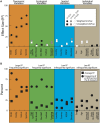Comparative Gut Microbiota of 59 Neotropical Bird Species
- PMID: 26733954
- PMCID: PMC4685052
- DOI: 10.3389/fmicb.2015.01403
Comparative Gut Microbiota of 59 Neotropical Bird Species
Abstract
The gut microbiota of vertebrates are essential to host health. Most non-model vertebrates, however, lack even a basic description of natural gut microbiota biodiversity. Here, we sampled 116 intestines from 59 Neotropical bird species and used the V6 region of the 16S rRNA molecule as a microbial fingerprint (average coverage per bird ~80,000 reads). A core microbiota of Proteobacteria, Firmicutes, Bacteroidetes, and Actinobacteria was identified, as well as several gut-associated genera. We tested 18 categorical variables associated with each bird for significant correlation to the gut microbiota; host taxonomic categories were most frequently significant and explained the most variation. Ecological variables (e.g., diet, foraging stratum) were also frequently significant but explained less variation. Little evidence was found for a significant influence of geographic space. Finally, we suggest that microbial sampling during field collection of organisms would propel biological understanding of evolutionary history and ecological significance of host-associated microbiota.
Keywords: Neotropical birds; V6; evolution; gut microbiota; host-associated microbiota.
Figures





References
-
- Bennett P. M., Owens I. P. F. (2002). Evolutionary Ecology of Birds: Life Histories, Mating Systems and Extinction. New York, NY: Oxford University Press.
LinkOut - more resources
Full Text Sources
Other Literature Sources

